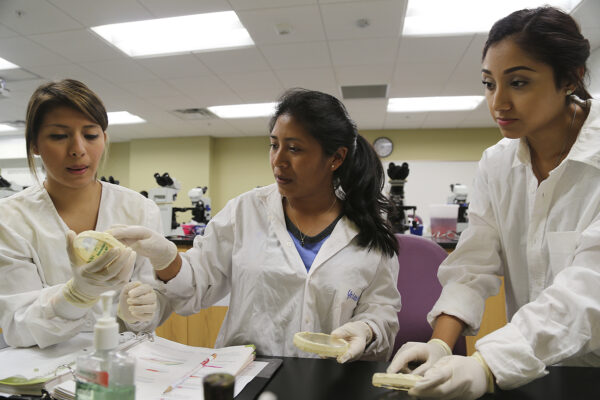By Caroline Harper
This post is the third in a series on campus climate and STEM success. ACE is partnering with the National Center for Institutional Diversity at University of Michigan on the series.
The demand for professionals in science, technology, engineering, and math, or STEM, has been on the rise since 2000—and projections indicate that the need for qualified candidates will not slow down any time soon. As new technology has driven market growth around the world, the United States has struggled to develop a workforce capable of maintaining a competitive edge in the global market. The ability to compete in the global market is contingent upon our ability to maximize resources that educate and prepare a diverse pipeline of students who understand the necessity of global citizenship.
During the White House College Opportunity Summit in 2014, President Obama reiterated the need to develop long-term strategies that expose students to STEM disciplines in elementary and middle school, increase college access, and maintain postsecondary affordability. These goals become increasingly important as projections indicate that more students from low-income and underrepresented minorities will pursue college degrees by 2025. According to the Bureau of Labor Statistics, women will make up 47.2 percent of the total labor force by 2024. It has become clear that postsecondary education is the gateway to obtaining professional opportunities in STEM occupations. In 2015, the Bureau of Labor Statistics confirmed that more than 99 percent of jobs in STEM required postsecondary education, compared to 36 percent of occupations overall.
The ability to create a pathway from degree attainment to gainful employment ensures that the STEM workforce reflects the diversity of our country. In recognizing this, the White House Council on Women and Girls and the Office of Science and Technology Policy have worked to encourage more women and girls to earn college degrees and pursue careers in STEM fields. But do existing strategies ensure a diverse STEM pipeline? Do these strategies reduce disparities between degree attainment and labor force outcomes among women and minorities?
Conditions of the STEM Pipeline
Although policy efforts to encourage STEM degree attainment are laudable, the STEM pipeline is leaky when it comes to underrepresented minorities. At the high school level, it is difficult to maintain a campus culture that encourages equity in the pursuit of STEM degrees when calculus and physics courses are available in only 33 percent and 48 percent of high schools with high black and Latino student enrollment, respectively.
Beyond access to courses that serve as the foundation to STEM careers, many black and Latino students have limited access to college and career readiness counselors. According to a national survey of school counselors, in high schools in which the student body is primarily low-income and/or underrepresented minority, the average caseload is at least 1,000 students per counselor—at least twice the national average. As a consequence of factors beyond their control, it is especially difficult for these students to successfully navigate a career trajectory that incorporates course selection, experiential learning opportunities, extracurricular activities, and college admission requirements.
Although many of the students aspire to attend college, black students are struggling to meet mathematics (13 percent), science (11 percent) and general STEM (4 percent) ACT test benchmarks, which are often seen as a measure of college readiness. What is the alternative for students who are interested in pursuing STEM careers but need additional resources to overcome limitations in their K–12 education?

Campus Culture and College Success
Despite limited access to resources during high school, students who choose to pursue their undergraduate degrees at Historically Black Colleges and Universities (HBCUs) are welcomed by a nurturing environment that provides critical resources to overcome academic, social, and financial hurdles. For more than 150 years, HBCUs have continued to serve first-generation, low-income, and underprepared students.
According to the U.S. Census Bureau, the number of traditional college-aged Americans is projected to grow to 13.3 million by 2025. The largest growth is expected to occur among students who identify as black, Hispanic, or Asian/Pacific Islander. In an analysis of black student graduation rates, about half of all four-year HBCUs enrolled freshmen classes where 75 percent of students were from low-income backgrounds, compared to 1 percent of the 676 non-HBCUs in the study. Among the institutions where 40–75 percent of the freshman class was low-income, the graduation rate for black students who attended HBCUs was 37.8 percent—five percentage points higher than their counterparts at non-HBCUs.
HBCUs produced 46 percent of black women who earned degrees in STEM disciplines between 1995 and 2004. HBCUs produced 25 percent of all bachelor’s degrees in STEM fields earned by African Americans in 2012. In 2014, black women represented the highest percentage of minority women who earned bachelor’s degrees in computer sciences. HBCUs such as North Carolina A&T State University, Howard University, Florida A&M University, and Xavier University of Louisiana continue producing undergraduate STEM degree earners who pursue graduate degrees in their field.
Beyond producing bachelor’s degrees, research confirms that HBCUs are the institution of origin among almost 30 percent of blacks who earned doctorates in science and engineering. According to the National Science Foundation, within STEM fields such as mathematics, biological sciences, physical sciences, agricultural sciences, and earth, atmospheric, and ocean sciences, a large percentage of doctorate degree holders earned their bachelor’s degrees at HBCUs
Career Outcomes
While the campus culture at HBCUs provides black students with a sense of community, self-confidence, and efficacy, the workforce provides a stark contrast. Relative to their share of degree attainment, blacks are underrepresented in the overall context of the workforce and earnings.
Research has shown that compared to their Hispanic and Asian counterparts, blacks have the highest rate of unemployment. Among minorities currently employed in a STEM occupation, 41.4 percent are Asian, 18.4 percent are Hispanic or Latino, and only 17.4 percent are black. Moreover, blacks who work full time, year-round in STEM occupations are paid less than their Asian and Hispanic counterparts.
Despite disparities in employment rates and income, there are still important achievements that should be considered as the STEM workforce continues to grow. Within mathematical occupations, there were more black operations research analysts than any other minority group in 2011. In engineering occupations, black engineers outnumbered other minorities in the petroleum engineering field and rivaled Asians in roles related to environmental engineering, surveyors, cartographers, and photogrammetrists. Black scientists outnumbered other minorities in chemical technician and nuclear scientist roles. Compared to their Hispanic counterparts, there was a higher percentage of black professionals in conservation sciences and forestry occupations and geological and petroleum technician roles.
Next Steps
While HBCUs do their share of producing black graduates with STEM degrees, there is a greater need for equity throughout the education pipeline and in workforce hiring practices. Suggestions to fill gaps in the STEM pipeline and ensure a diverse workforce that increases our ability to compete internationally include:
- Ensure that high schools serving low-income and minority students are provided with adequate resources to hire additional school counselors proportional to the student body and with the capacity to help students develop strategies to achieve college and career readiness.
- Provide funding to support collaborations with organizations that encourage academic rigor in STEM disciplines, including calculus and physics, in addition to advanced placement and honors courses. Specifically, funds should be designated to increase access to STEM foundation courses, advanced placement, and honors courses.
- Encourage private corporations to actively engage in the process of creating a diverse workforce by developing partnerships that encourage diversity in recruitment, hiring, and development of African American college students pursuing degrees in STEM disciplines.
- Develop internship opportunities in collaboration with HBCU campuses to provide students with opportunities to put their coursework into practice while developing skills that can be transferred into the workforce.
HBCUs have maintained their legacies of producing African American professionals in critical professions. Staying true to their mission, HBCUs continue to provide a nurturing environment where students gain academic and professional training to drive innovation in STEM fields and make valuable contributions in communities around the world.
If you have any questions or comments about this blog post, please contact us.


